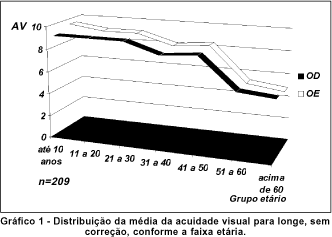Purpose: To determine the prevalence of low visual acuity (VA) in a populational sample, with a differentiated social pattern. Methods: This was a prevalence study, in which the 213 volunteers' VA, examined in a shopping mall in Porto Alegre, was verified through the Ortho-Rater device, from Bausch & Lomb. Far sight VA was measured in all the individuals and in those who were 40 years old or older, near sight VA, both of them without and with correction. VA was considered low when it was less than 10 (equivalent to 20/20 on the Snellen chart). Results: The age group varied from 6 to 75 years, presentig a mean ± standard deviation of 27.8 ± 15.16 years, most belonging to the range between 10 and 40 years. A prevalence of 38.7% (IC 95%: 32.1-45.7) of low far sight VA in both eyes was detected. 24.9% (IC 95%: 19.2-31.3) presented binocular visual deficit and they didn't use any optic correction. For near sight VA, it was observed that 70.8% (IC 95%: 55.9-83) of the tested individuals presented binocular visual deficit without correction and 41.7% (IC 95%: 27.6-56.8) presented low VA, independent of the correction used. Conclusion:This study demonstrated that a considerable part of the population has low visual acuity, needing adequate evaluation and handling. It is concluded that visual screening programs and ocular health orientation are important for any group and should reach different socioeconomic levels.
Visual acuity; Mass screening; Health promotion



